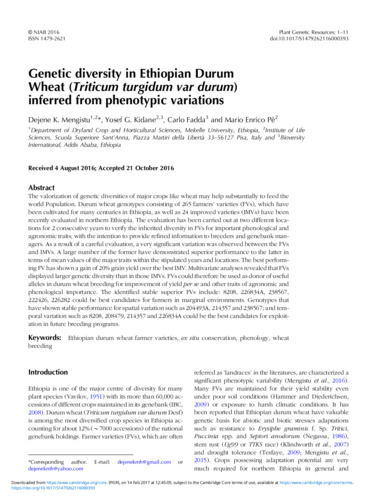Genetic diversity in Ethiopian Durum wheat ( Triticum turgidum var durum ) inferred from phenotypic variations
The valorization of genetic diversities of major crops like wheat may help substantially to feed the world Population. Durum heat genotypes consisting of 265 farmers’ varieties (FVs), which have been cultivated for many centuries in Ethiopia, as well as 24 improved varieties (IMVs) have been recently evaluated in northern Ethiopia. The evaluation has been carried out at two different locations for 2 consecutive years to verify the inherited diversity in FVs for important phenological and agronomic traits; with the intention to provide refined information to breeders and genebank managers. As a result of a careful evaluation, a very significant variation was observed between the FVs and IMVs. A large number of the former have demonstrated superior performance to the latter in terms of mean values of the major traits within the stipulated years and locations. The best perform-
ing FV has shown a gain of 20% grain yield over the best IMV. Multivariate analyses revealed that FVs displayed larger genetic diversity than in those IMVs. FVs could therefore be used as donor of useful alleles in durum wheat breeding for improvement of yield per se and other traits of agronomic and phenological importance. The identified stable superior FVs include: 8208, 226834A, 238567, 222426, 226282 could be best candidates for farmers in marginal environments. Genotypes that
have shown stable performance for spatial variation such as 204493A, 214357 and 238567; and temporal variation such as 8208, 208479, 214357 and 226834A could be the best candidates for exploitation in future breeding programs.

